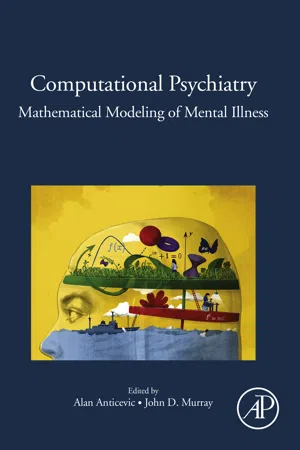
Computational Psychiatry
Mathematical Modeling of Mental Illness
- 332 pages
- English
- ePUB (mobile friendly)
- Available on iOS & Android
About This Book
Computational Psychiatry: Mathematical Modeling of Mental Illness is the first systematic effort to bring together leading scholars in the fields of psychiatry and computational neuroscience who have conducted the most impactful research and scholarship in this area. It includes an introduction outlining the challenges and opportunities facing the field of psychiatry that is followed by a detailed treatment of computational methods used in the service of understanding neuropsychiatric symptoms, improving diagnosis and guiding treatments.
This book provides a vital resource for the clinical neuroscience community with an in-depth treatment of various computational neuroscience approaches geared towards understanding psychiatric phenomena. Its most valuable feature is a comprehensive survey of work from leaders in this field.
- Offers an in-depth overview of the rapidly evolving field of computational psychiatry
- Written for academics, researchers, advanced students and clinicians in the fields of computational neuroscience, clinical neuroscience, psychiatry, clinical psychology, neurology and cognitive neuroscience
- Provides a comprehensive survey of work from leaders in this field and a presentation of a range of computational psychiatry methods and approaches geared towards a broad array of psychiatric problems
Frequently asked questions
Information
A Case Study in Computational Psychiatry
Addiction as Failure Modes of the Decision-Making System
Abstract
Keywords
Table of contents
- Cover image
- Title page
- Table of Contents
- Copyright
- Contributors
- Preface
- Meeting Emerging Challenges and Opportunities in Psychiatry Through Computational Neuroscience
- Section I. Applying Circuit Modeling to Understand Psychiatric Symptoms
- Section II. Modeling Neural System Disruptions in Psychiatric Illness
- Section III. Characterizing Complex Psychiatric Symptoms via Mathematical Models
- Index